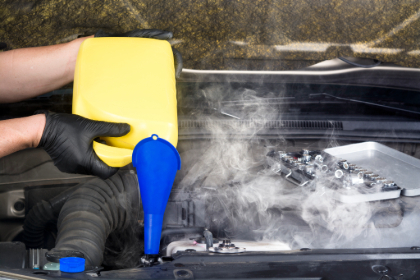INDEPENDENT DEALER
Fort Worth, TX & Southlake | (888) 459-9958 / (817) 431-6664
Ace Hi Oil
OUR BLOG
10/07/2025
Texas weather destroys engines fast! Ace Hi Oil in Fort Worth, TX, reveals the coolant system maintenance secrets that save thousands in repair costs.

Stop gambling with your engine's life and contact Ace Hi Oil in Fort Worth, TX, at (888) 459-9958 or visit AMSOIL's online store for cooling system maintenance products that provide the ultimate protection when volatile temperatures push your vehicle to its breaking point.
When Fort Worth thermometers climb above triple digits for weeks at a time, your vehicle's cooling system becomes the unsung hero keeping your engine from turning into expensive scrap metal. Texas weather doesn't just test your air conditioning—it pushes every component of your coolant system maintenance routine to its absolute limits.
Essential Coolant System Maintenance Checklist
1. Check Coolant Levels Weekly
Never let your coolant reservoir drop below the minimum line. Low coolant levels mean reduced heat transfer capacity right when your engine needs maximum cooling protection. Check levels when the engine is cold, preferably first thing in the morning, before the day's heat builds up.
2. Inspect Hoses and Connections Monthly
Extreme heat can make rubber hoses brittle and prone to sudden failure. Look for cracks, soft spots, or bulging areas that indicate imminent failure. A blown radiator hose in 105°F weather isn't just inconvenient—it's dangerous. Replace any questionable hoses before they strand you in dangerous heat conditions.
3. Test Your Thermostat Performance
Your thermostat controls when coolant flows through the radiator, and Texas’s weather can cause thermostats to stick or fail altogether. If your temperature gauge reads higher than usual or fluctuates wildly, your thermostat might struggle with extreme operating conditions.
4. Clean Your Radiator and Condenser
Texas dust, construction debris, and cottonwood seeds clog radiator fins faster than expected. A blocked radiator can't dissipate heat effectively, forcing your engine to run dangerously hot even with perfect coolant. Use compressed air to blow debris out from behind the radiator monthly during peak months.
Before your cooling system becomes another casualty of brutal Texas weather, call the experts at Ace Hi Oil in Fort Worth, TX, at (888) 459-9958 or check out AMSOIL's online store to discover cooling system products engineered to handle whatever Mother Nature throws at North Texas drivers.
Advanced Coolant System Maintenance
Pressure Test Your System
Heat causes expansion and contraction, which can create microscopic leaks in your cooling system. Annual pressure testing identifies weak points before they become roadside emergencies. Small leaks become big problems quickly when ambient temperatures exceed 100°F for days at a time.
Consider Coolant Quality Upgrades
Standard coolant formulations struggle in extreme heat conditions. High-quality coolants with extended service intervals provide better heat transfer and longer-lasting protection against the corrosive effects of Texas temperatures. Look for coolants specifically designed for severe service conditions.
Monitor Water Pump Performance
Your water pump circulates thousands of gallons of coolant daily. Listen for unusual noises, watch for coolant leaks near the water pump, and observe temperature gauge readings that indicate reduced circulation efficiency.
Experience superior cooling performance with AMSOIL Propylene Glycol Antifreeze and Engine Coolant. Call Ace Hi Oil in Fort Worth, TX, at (888) 459-9958 or stop by the AMSOIL online shop for the responsible coolant choice that Fort Worth families trust.
Recognizing Cooling System Problems Early
Don't wait for steam to pour from your hood to address cooling system issues. Early warning signs include slightly higher temperature gauge readings, sweet smells from the engine bay, or white residue around the radiator cap. Check your coolant color regularly—fresh coolant should be bright green, orange, or pink, depending on the type. Brown or rusty coolant indicates system contamination that requires immediate attention.
Emergency Overheating Procedures
If your temperature gauge climbs into the red zone, pull over immediately and turn off the engine. Never remove the radiator cap from a hot engine - pressurized coolant can cause severe burns. Call for help rather than attempting repairs without proper tools and safety equipment.
If you must drive a short distance to safety, turn your heater on full blast. This helps dissipate engine heat through the passenger compartment, though it makes for an uncomfortable but potentially vehicle-saving ride.
Remember that proper coolant system maintenance isn't optional in Texas - it's essential insurance against expensive engine damage and dangerous roadside breakdowns when temperatures soar above 100°F for weeks at a time.
For expert cooling system service and premium AMSOIL coolant products, call Ace Hi Oil in Fort Worth, TX, at (817) 524-0375 or visit AMSOIL's online store to find products engineered for extreme heat performance.
CONTACT
Norman Rinehart
2900 Knight Ct
Southlake, TX, 76092
United States
United States
(888) 459-9958
(817) 431-6664